| |
| |
Photographer,
Location |
Images |
Comments |
|

|
Tamas Ladanyi,
Bakony-mountain (Hungary), on the 29th of November 2007.
Nov. 29, 2007 |
#1,
more |
Very nice view with the NGC 1245 open cluster.
Modified Canon EOS 300D, 5,6/400 objectiv, 7x300 sec, iso 800. At cold, clear and windy night.
|
|

|
Jan Timmermans,
Valkenswaard, The Netherlands
Nov. 29, 2007 |
#1,
more |
After a rainy day it cleared late in the evening: comet time for me !
I think I captured my best Holmes image so far; the coma is huge indeed and is almost exceeding the FOV of my William Optics Zenithstar 80 ED II APO with Meade 3.3 Focal Reducer at f/3 [focal length 240 mm] and ATK16IC camera.
I measured the size of the coma: a staggering 38.3 arc minutes across (the sun is approximately 32 arc minutes).
|
|
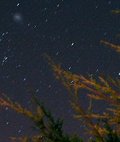
|
John C McConnell,
Maghaberry Northern Ireland.
Nov. 28, 2007 |
#1 |
Comet 17P/Holmes still outshines everything else in the sky even the low rising moon.Not having seen it for a few days because of poor weather I was surprise to be able to find and image it without even looking for it. This image was taken with the Canon 400D lens set on 35mm at f6.3 with the button held down manually for 64 seconds. It's a pity it too late to have it printed as a Christmas card!
|
|
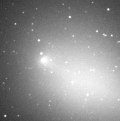
|
Apostolos Christou and David Asher,
Armagh Observatory, UK
Nov. 22, 2007 |
#1,
more |
The comet was so large that we hardly fit it in the CCD frame!
Photo details: Celestron 15 cm Newtonian, ST-7, 30s exposure, taken at 45 min interval
|
|
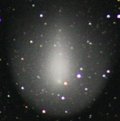
|
Mike Borman,
Evansville, Indiana
Nov. 29, 2007 |
#1,
more |
Comet Holmes was still easy to spot with the naked eye from my suburban home and is noticeably bigger than when I last observed it on the 19th.
Photo details: Canon 20Da DSLR with Sigma 28-300mm zoom lens set to 300mm, ISO 1600, on a Vista tracking platform. Combination of four one minute exposures.
|
|
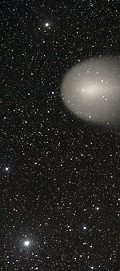
|
Martin Mutti,
Gurnigel, Switzerland: 46.8deg N, 7.5deg E
Nov. 28, 2007 |
#1 |
With the naked eye, 17p/Holmes looks a bit brighter than the double cluster in Perseus.
I used a 200mm Canon-Lens by f=2.8. The camera is a canon EOS20da.
The picture is the result of 30 stacked 2 min/1'600ASA-Exposures.
|
|

|
Pavol Rapavy,
Rimavska Sobota, Slovakia
Nov. 28, 2007 |
#1,
more |
Animation comet 17P/Holmes, Nov 27 - Nov 28, 5.6/300, CCD camera SHT 1.3, exp. 10x20s
|
|
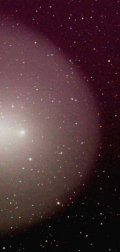
|
John R. Henley,
Starfield Observatory, Nambour, Queensland, Australia
Nov. 29, 2007 |
#1,
more |
Although transitting, the comet was only 14 degrees above the theoretical horizon. Clearly visible to the unaided eye despite light pollution in that direction. Diameter of ejecta cloud approx. 40 arcminutes. Canon 40D, Williams Optics FLT 110 apo refractor on Paramount ME, 8 minutes at ISO 800.
|
|
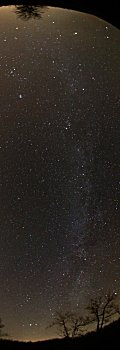
|
Tunç Tezel,
near Bolu, Turkey
Nov. 29, 2007 |
#1,
|
After a month,
comet Holmes still rules the sky. And the total brightness
of the comet is still around 3; but it looks much brighter
in this all-sky picture, thanks to its large angular size.
Cmpare it with this
identical picture of 9th November, when it was half
the size across. I used a Canon EOS 5D at ISO 1600, 8 mm
fisheye lens at f/4 and a 1.5-minute exposure. |
|

|
Jay Edwards,
Maine, NY
Nov. 29, 2007 |
#1 |
Due to the large size of the comet I had to use a short focal length camera lens in order to fit the entire object into the field of view. Photo details: MX716 CCD, 55 MM FL lens at f/4, LRGB filters, 55 min total exposure time.
|
|

|
Thorsten Boeckel,
Auerberg,Bavaria,South Germany
Nov. 28, 2007 |
#1,
more |
Due to the comet measures visual 45 arcmin, the diameter must reach up to 3,7 million kilometers. 17P/Holmes is fading surprising less (may 3,5 mag*). No problem to see the diffuse ball in dark areas with naked eye. The comets surrounding material in comparison to the 1,5 x moon diameter makes it easy to discover, although the brightness is declining. Watch vertical at midnight!
|
more
images (Nov. 28-29): from
Martin Mc Kenna of Maghera, Co. Derry, N. Ireland; from
Phillip Chee of Peterborough, Ontario, Canada; from
Curtis Warrenfeltz of Virginia Beach, VA; from
Albert Sciesielski of Waiblingen-Bittenfeld, Germany; from
Ugur Ikizler of Mudanya - Bursa / Turkey; from
LARUE of Nancy, Lorraine, France
more
images (Nov. 26-27): from
Mila Zinkova of San Francisco, California, USA; from
Colzani Enrico and Ventre Graziano of Colma del Piano, Sormano(Co),
Italy; from
Guenter Kleinschuster of Feldbach, Styria, Austria; from
Jari Kankaanpää of Kauhava, Finland;
|
|